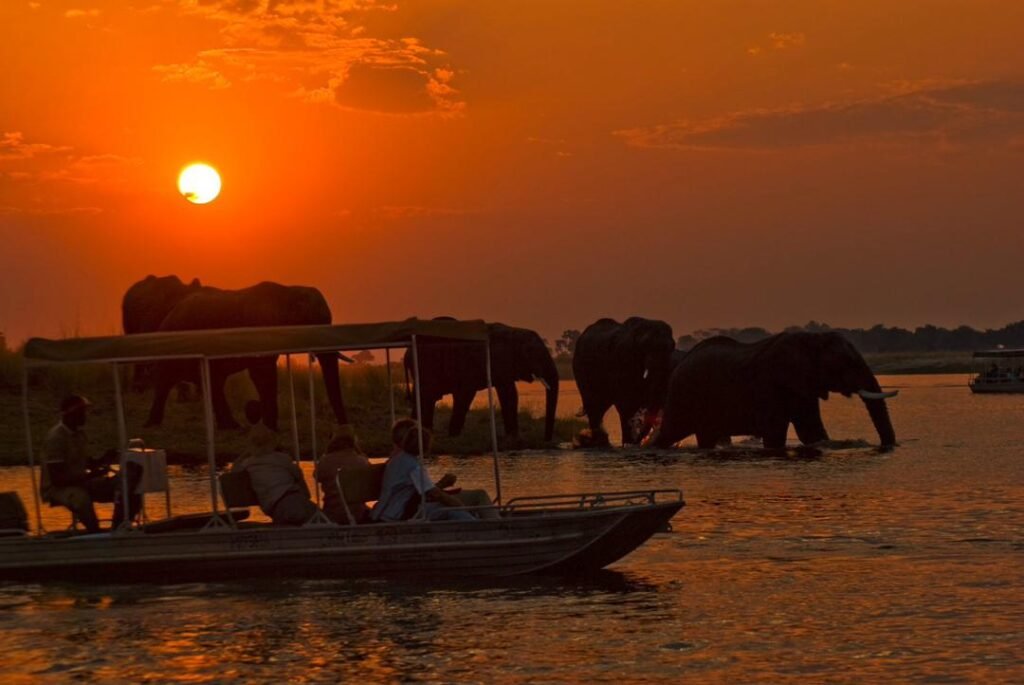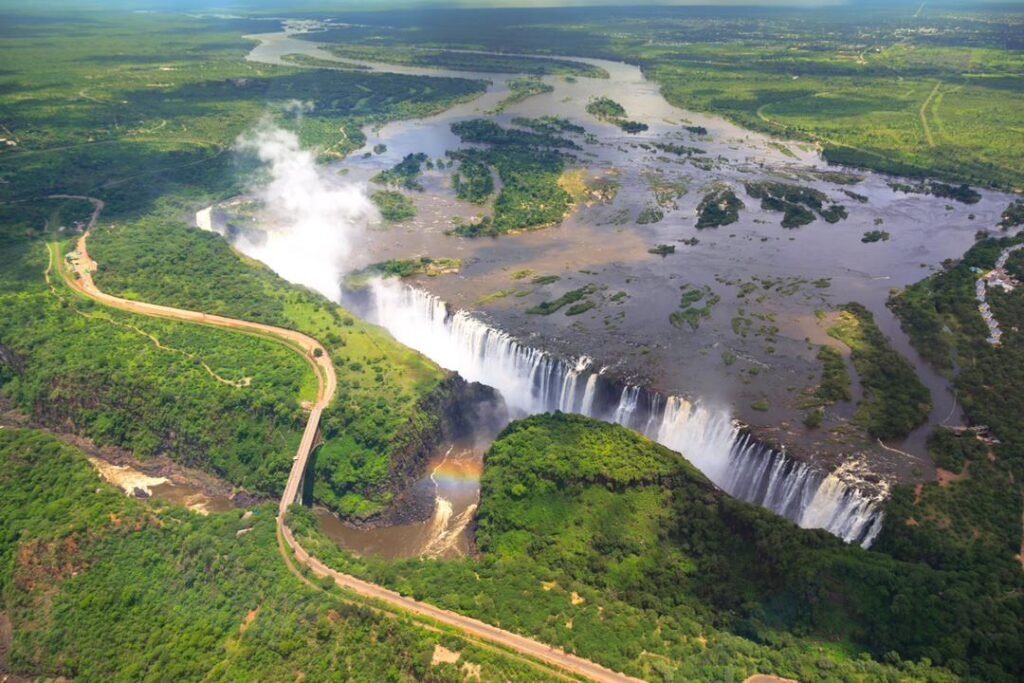
Introduction to Victoria Falls
Victoria Falls, one of the Seven Natural Wonders of the World, majestically straddles the border between Zambia and Zimbabwe. Known locally as ‘Mosi-oa-Tunya’ or ‘The Smoke that Thunders,’ this awe-inspiring waterfall is among the most visited natural landmarks globally. The falls are formed by the mighty Zambezi River, and the roar of the water plunging into the gorge below can be heard from miles away, creating an experience that is both visually and audibly breathtaking.
Geographically, Victoria Falls is a marvel. The Zambezi River, which feeds the falls, is the fourth longest river in Africa and one of the few rivers in the world that flow across a plateau, creating a unique and dramatic landscape. The falls themselves are approximately 1,708 meters wide and 108 meters high, making them one of the largest and most impressive waterfalls on the planet. The surrounding area is a UNESCO World Heritage site, further highlighting its global significance.
From a cultural perspective, Victoria Falls holds a special place in the hearts of the local communities. The name ‘Mosi-oa-Tunya’ reflects the powerful presence the falls have in the local folklore and traditions. The falls are not just a natural wonder but a symbol of life and sustenance for the people living in the region. Local guides often share stories and legends associated with the falls, enriching the visitor experience with a deep sense of place and history.
Visitors to Victoria Falls can engage in a multitude of unique experiences that cater to adventure enthusiasts and nature lovers alike. Activities range from exhilarating bungee jumping and white-water rafting on the Zambezi River to more serene pursuits like guided tours and wildlife safaris. The falls also provide a stunning backdrop for photography, making it a paradise for photographers. For those on a budget, there are numerous affordable accommodations and guided tours available, ensuring that the splendor of Victoria Falls is accessible to all.
Seasonal Variations: High Water vs. Low Water

Victoria Falls, one of the most iconic travel destinations in Africa, offers distinct experiences depending on the season. Known locally as “The Smoke That Thunders,” this majestic waterfall has two main periods: the high water season from February to May and the low water season from August to November. Each season brings unique characteristics that significantly influence your adventure and activities.
During the high water season, Victoria Falls demonstrates its full power and grandeur. The Zambezi River swells, creating a spectacular and thunderous display. This period is ideal for those who wish to witness the falls in their most dramatic form. The volume of water is immense, resulting in a dense mist that rises high into the sky, often visible from miles away. However, the heavy mist can sometimes obscure visibility, making it challenging to capture clear photographs. The high water season is perfect for travelers who relish the raw, untamed beauty of nature and the sheer force of the falls.
In contrast, the low water season offers a different yet equally captivating experience. As the water levels drop, the curtain of water becomes less intense, providing clearer views of the rock formations and the full breadth of the falls. This period is particularly advantageous for activities such as swimming in the Devil’s Pool, a natural rock pool at the edge of the falls, which becomes accessible only when the water flow is reduced. Additionally, the lower water levels enhance opportunities for river rafting and exploring the Zambezi’s islands and gorges. For those interested in a broader range of adventure activities and better visibility, the low water season is an excellent choice.
Ultimately, the best time to travel to Victoria Falls depends on what you seek from your visit. Whether you’re drawn to the awe-inspiring power of the high water season or the diverse activities and clearer views of the low water season, Victoria Falls promises an unforgettable experience in any season.
Weather Considerations: Temperature and Climate
When planning a trip to Victoria Falls, understanding the region’s climate is crucial. The climate here can be broadly categorized into two main seasons: the dry season, which spans from May to October, and the wet season, which lasts from November to April. Each season offers unique experiences, impacting travel conditions and comfort levels, and thus dictates the type of clothing and gear visitors should pack.
During the dry season, temperatures typically range from a comfortable 15°C (59°F) in the mornings and evenings to around 28°C (82°F) during the day. This period is often considered ideal for a safari adventure, as the drier conditions make it easier to spot wildlife congregating around the Zambezi River. The reduced humidity levels also contribute to a more pleasant travel experience. However, the “Smoke that Thunders,” as Victoria Falls is affectionately known, may not be as thunderous due to lower water levels.
Conversely, the wet season brings higher temperatures, averaging between 18°C (64°F) and 32°C (90°F), accompanied by increased humidity. The rains, while sporadic, can be heavy, leading to lush, green landscapes and fuller, more dramatic waterfalls. This is the best time to witness Victoria Falls in its full glory, with the Zambezi River swelling and the falls producing a massive spray that can be seen from miles away. However, the higher humidity and potential for rain showers necessitate lightweight, breathable clothing and rain gear for comfort.
Visitors should consider their personal preferences and travel goals when choosing the best time to visit. Whether it’s the desire for a picturesque safari in the dry season or the breathtaking spectacle of the falls in the wet season, understanding the weather patterns will ensure a more enjoyable and well-prepared journey to this iconic African destination.
Top Attractions and Activities by Season
Victoria Falls, often referred to as “The Smoke That Thunders,” is a year-round destination that offers a diverse range of attractions and activities, each season bringing its unique charm and opportunities. Understanding the best time to engage in specific activities can significantly enhance your travel to Africa, particularly Zimbabwe, making your adventure unforgettable.
During the wet season, from November to April, Victoria Falls is at its most dramatic. The Zambezi River swells, and the falls are a magnificent spectacle of thundering water and mist. This is the ideal time for helicopter tours, offering a bird’s-eye view of the falls in their full glory. Walking safaris in the surrounding rainforests are also more captivating, as the lush greenery comes alive with flora and fauna. However, due to the high water levels, activities such as white-water rafting may be limited to the lower river sections.
The dry season, from May to October, brings a different but equally enthralling experience. The receding water levels reveal the geological formations and the impressive width of the falls. This period is perfect for bungee jumping from the Victoria Falls Bridge, offering an exhilarating plunge into the gorge. White-water rafting is at its peak, with challenging rapids providing an adrenaline rush. Additionally, this is the best time for wildlife viewing in nearby national parks like Hwange and Chobe, as animals gather around water sources, making sightings more frequent and diverse.
Seasonal events and festivals add another layer of excitement to a Victoria Falls itinerary. The Victoria Falls Marathon in June attracts runners from around the world, combining fitness with breathtaking scenery. The annual Zambezi River Music Festival in August is a cultural highlight, featuring local and international artists. Visiting during these events can offer a unique glimpse into the vibrant local culture and community spirit.
In planning your budget travel to Zimbabwe, consider the seasonal variations in activities at Victoria Falls to maximize your adventure. Whether you’re seeking the thrill of extreme sports, the serenity of a scenic tour, or the richness of wildlife encounters, timing your visit can make all the difference in creating a memorable experience.
